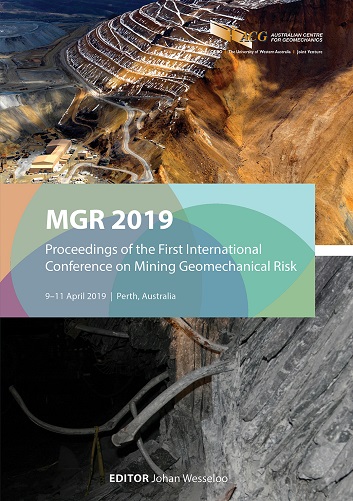Risk-based access control at Mount Isa Copper Operations

|
Authors: Potgieter, GS; Grubb, AB |
DOI https://doi.org/10.36487/ACG_rep/1905_0.4_Potgieter
Cite As:
Potgieter, GS & Grubb, AB 2019, 'Risk-based access control at Mount Isa Copper Operations', in J Wesseloo (ed.), MGR 2019: Proceedings of the First International Conference on Mining Geomechanical Risk, Australian Centre for Geomechanics, Perth, pp. 47-60, https://doi.org/10.36487/ACG_rep/1905_0.4_Potgieter
Abstract:
Mount Isa Copper Operations (MICO) is one of the oldest and deepest mines in Australia, comprising the largest underground network of mine development in the world. During the early operational years, ground support, particularly surface support, was not routinely installed. Although rehabilitation in recent years has drastically reduced the amount of tunnel without support, there remain tens of kilometres of excavation with limited to no ground support installed. In addition, older development was often mined within close proximity to unfilled or partially filled stopes and vertical openings. The voids pre-date modern 3D mine plans and scanning technology. Furthermore, access to the voids to conduct scans is limited, this results in an imperfect understanding of the void sizes and proximity to accessible drives. The lack of ground support and knowledge of void status poses significant ground failure risks at MICO. A significant increase in rock related near-hit incidents occurred during the second half of 2014 and the first half of 2015. A number of these incidents had the potential to cause severe or fatal harm. The incidents triggered internal investigations that aimed at understanding and reducing the ground failure risk. The outcome of the investigations was the creation of a series of interlinked systems, namely the tunnel condition risk assessment (TCRA), mine closure areas (MCA), ground awareness training (GAT), vertical opening pillar hazard assessment and control (VOPHAC), stope void review (SVR), manual scaling crews, fall of ground database and the quality assurance/quality control management plan (QA/QC MP). The individual components of the system are specialised and simple. However, the system is comprehensive and robust. Each of the components, as well as how they interlink, is discussed within this paper. The interlinked systems and practices provide controls and have proven to be effective at reducing the ground failure risks. Although the systems were developed at MICO, they have the potential to be easily adapted and utilised at other mine sites.
Keywords: Mount Isa, rock mechanics, risk, hazard, ground failure, ground control, tunnel condition risk assessment, mine closure areas, quality assurance/quality control
References:
ACG 2005, Reading the Ground: A Geotechnical Hazard Awareness Training DVD for Underground Metalliferous Mine Workers, DVD, ACG, Perth.
ICMM 2015, Health and Safety Critical Control Management Good Practice Guide, ICMM, London.
Jobs, S 2015, Motivating Thoughts of Steve Jobs, Prabhat Prakashan, New Delhi.
Monk, JL 2004, Rockfall Risk Management – Prediction of Rockfall Likelihood at Mount Isa Underground Copper Mine, Bachelor of Engineering thesis, The University of Sydney, Sydney.
Standards Australia 1999, AS/NZS 4360:1999 Risk Management, Standards Australia, Sydney.
Thin, I & Westerman, M 2001, A Guideline to the Copper Mine Ground Control Risk Management Plan, internal Mount Isa Mines document, Mount Isa Mines, Mount Isa.
WAGCWG 2000, Rock Fall Risk Assessment Guidelines for Underground Mine Access, WAGCWG, Perth.
© Copyright 2025, Australian Centre for Geomechanics (ACG), The University of Western Australia. All rights reserved.
View copyright/legal information
Please direct any queries or error reports to repository-acg@uwa.edu.au
View copyright/legal information
Please direct any queries or error reports to repository-acg@uwa.edu.au
